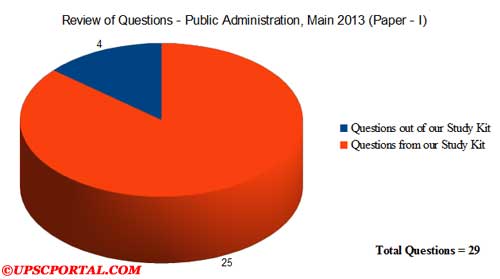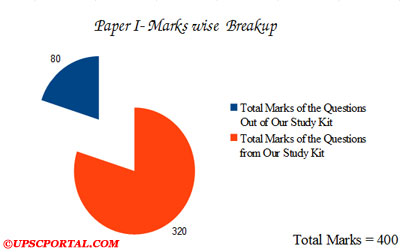(Questions Review) Public Administration, Main 2013 (Paper - I)
Review of Questions - Public Administration, Main 2013 (Paper - I)
UPSC comes with new word limits here: 10 marks = 150 words and 20 marks = 250 words. There is one question worth 30 marks- but word limit not mentioned. Each Paper (I and II) with 250 marks and 3 hours’ time limit.
The Question Paper remains same like earlier (before 2013) i.e.
- Eight Questions in two sections (A and B)
- Candidate has to attempt five questions.
- Question No. 1 and 5 are compulsory.
- Out of the remaining, pick any three- but choose at least one from each section.

IAS Main 2013: Public Administration: Question Paper I
Total Time 3 Hours Total Marks 250
Question Paper Specific Instructions
- Please read each of the following instructions carefully before attempting questions:
- There are EIGHT questions divided in two SECTIONS and printed both in HINDI and in ENGLISH.
- Candidate has to attempt FIVE questions in all.
- Questions no. 1 and 5 are compulsory and out of the remaining, THREE are to be attempted choosing at least ONE from each section.
- The number of marks carried by a question/part is indicated against it.
- Answer must be written in the medium authorized in the Admission Certificate which must be stated clearly on the cover of this Question-cum-Answer (QCA) Booklet in the space provided. No marks will be given for answer written in a medium other than the authorized one.
- Word limit in questions, wherever specified, should be adhered to.
- Attempts of questions shall be counted in chronological order. Unless struck off, attempt of a question shall be counted even if attempted partly. Any page or portion of left blank in the answer book must be clearly struck off.
SECTION - A
Q.1. Answer the following questions in not more than 150 words each: 10x5=50
(a) How did traditional public administration ''resolve a fundamentally
irresolvable problem-creating an administration strong enough to be effective
but not so strong enough to endanger accountability''? 10
(This question from our
Public Administration Study Kit-Chapter
1- Page No-1 to 2)
(b) The theory of 'organizational incompetence' has two separate and distinct
faces. Examine Chris Argyris' views on this. 10
(This question from our
Public Administration Study Kit-Chapter-2-
Organisational Structure of Chris Argyris)
(c) ''In the globalized public administration, hierarchy creates more ethical
problems than it solves...''Comment. 10
(This question from our
Public Administration Study Kit-Chapter2-
Page No-19 to 22)
(d) Public Administration in the neo-liberal era is governed less by
instruments of internal accountability and more by those of external
accountability. Elaborate. 10
(This question from our
Public Administration Study Kit-Chapter-5-
Page No-16 to 17)
(e) Discuss the view that ''tribunals should have the same degree of
independence from the executive as that enjoyed by the Supreme Court and the
High Courts, especially for those tribunals that look over the functions of High
Courts.''10
(This question from our
Public Administration Study Kit-Chapter-6-
Page No-111 to 113)
Q.2. (a) "New Public Management may have neither been the saviour its
enthusiasts promised nor the devil its critics worried it would be." Discuss. 25
(This question from our
Public Administration Study Kit-Chapter
-1- Page No-13 to 15)
(b) "The design of the physical structure, the anatomy of the organization came
first, and was indeed the principal consideration."
"An organization is a system of interrelated social behaviours of participants."
Analyse these statements and evaluate the contributions of the respective
approaches to administration theory. 25
(This question from our
Public Administration Study Kit-Chapter-2-
Page No-33 to 39)
Q.3. (a) "Decisions are not made by 'organizations', but by 'human beings'
behaving as members of organizations." How do Bernard and Simon conceptualize
the relation between the decisions of the individual employee and the
organizational authority? 20
(This question from our
Public Administration Study Kit-Chapter-2-
Page No-37 to 38)
(b)"A variety of different organizational arrangements can be used to provide
different public goods and services." Explain the theory underlying this
proposition and its potential contribution. 15
(This question from our
Public Administration Study Kit-Chapter-1-
Page No-16 to 17)
(c) What is the nature of psychological contract pursued by organizational
management through authority and the employees through exertion of upward
influence? 15
(This question from our
Public Administration Study Kit-Chapter-2-
Page No-48 to 53)
Q.4. (a) Structural theory is, by and large, grounded in classical principles
of efficiency, effectiveness and productivity. Explain. 25
(This question from our
Public Administration Study Kit-Chapter-2-
Page No-18 to 22)
(b) "Public interest is still inadequate as a ground concept to evaluate
public policy." Discuss. 25
(This question from our
Public Administration Study Kit-Chapter-1-
Page No-180 to 181)
SECTION - B
Q.5. Answer the following questions in not more than 150 words each: 10x5=50
(a) "Comparative Public Administration both resembles and differs from modern
organization theory." Elaborate. 10
(This question from our
Public Administration Study Kit-Chapter-7-
Page No-114 to 115)
(b) "In organizational analysis there is always gender around." (Gouldner).
Argue 10
(This question from our
Public Administration Study Kit-Applied
question – Elaborate this statement of Gouldner)
(c) What is administrative elitism? How does it evolve in public
administration? Elaborate your response with reference to historical examples.
10
(This question from our
Public Administration Study Kit-Chapter-10-
Public Policy-Elite State)
(The Administrative Cadre of the civil service preserves the elitist tradition in supportive political conditions. It virtually shields itself from other functional groups and its members occupy key positions in the governmental structure and wield tremendous power and authority over policy making. Indoctrination and training is its own preserve and highly politicised groups within it regulate civil service recruitment and placements. Within the Administrative Cadre, elite integration is strong, while there is wide differentiation between this group and other cadres. Reform attempts failed to make inroads into changing bureaucratic behaviour mainly due to resistance from the elitist cadre, which remains the dominant instrument of the political executive.)
(d) The success rate of e-government projects in most developing countries is
stated to be rather low. Assess the reason. 10
(This question from our
Public Administration Study Kit-Chapter-11-
Page No-193 to 194)
(e) What new models of budgetary capacity and incapacity have emerged after
the decline of Planning Programming Budgeting and Zero-based Budgeting? 10
(This question from our
Public Administration Study Kit-Chapter-12-
Page No-207 to 210)
Q.6. (a) "For those who use the euphemism of 'shared power' for
participation, the appropriate literature for guidance is practical politics,
not organization and management."
"Strong state and strong civil society are the need to develop both
participatory democracy and responsive government as mutually reinforcing and
supportive." Bring out the myths and realities associated with public
participation. 20
(This question from our
Public Administration Study Kit-Chapter-5-
Page No-88 to 91)
(b) "..... in most cases .... newly independent states, of the nations of
Africa, Asia and Latin America, despite their differences .... are in
transition." (Ferrel Heady). What common features are indicative of
characteristics of their administrative patterns (cultures)? 15
(This question from our
Public Administration Study Kit-Chapter-7-
Page No-115 to 116)
(c) "To talk about the regulatory framework is to talk about governance."
Analyse the statement in the context of public-private-partnerships and identify
the elements of regulation. 15
(This question from our
Public Administration Study Kit-Chapter-4-
Page No-73 to 76)
Q7. (a) “Economic reforms are a work in progress with the state reluctant to
fully relinquish its reins.”Discuss the statement with regard to implementation
of economic reforms in India. 15
(This question from our
Public Administration Study Kit-Chapter-1-
Page No-17)
(b) “The policy process was not structured in the way required by
bureaucratic planning.”
“Arguably, incrementalism now stands most in contrast to neo-liberal nationality
that impose markets against both gradual change and democratic
liberalism.”Analyse these two statements. 20
(This question from our
Public Administration Study Kit-Chapter-10-
Page No-176 to 178)
(c) Budget allocation involves series of tensions between actors with
different backgrounds, orientations and interests and between short-term goals
and long term institutional requirements. Discuss. 15
(This question from our
Public Administration Study Kit-Chapter-12-
Page No-210 to 216)
Q8. (a) Read the following instances carefully and suggest what specific
perspectives on organizational psychology of motivation would help the concerned
organization to reconcile the needs of the following four persons with the needs
of the organization: 30
(This question from our
Public Administration Study Kit-Chapter-3-
Read our booklet on ‘Motivation’)
(i) Mr. A comes to his office with clocklike punctuality; does his work with impeccable honesty and integrity; takes order from above gladly; responds well to overtures by peers; but neither mixes with anyone himself nor seeks anyone's company. What is more, he seems quite happy in his isolation.
(ii) Mr. B is an efficient charge-hand at the welding shop. He is very outgoing and makes friends fast , but falls out with them very fast too. He is however easily pacified when anyone asks him to calm down in the name of the organization.
(iii) Dr. C is completely happy and absorbed when he is teaching in the classes, and does not at all mind when his workload gets heavier and covers new areas. But he gets angry when the finance section raises objections about his medical bills; and is furious that the higher administration is yet to give him full tenure.
(iv) Mr. D is a metallurgist in the forge shop of the steel plant, and has received honours for his innovativeness in modifying conventional alloys. He also paints well and values his painting skills far more than his metallurgy and is extremely unhappy that the company house journal did not finally carry his water sketch on its front cover.
(b) Suppose the Government of India is thinking of
constructing a dam in a mountain valley girded by forests and inhabited by
ethnic communities. What rational techniques of policy analysis should it resort
to for coping with likely uncertainties and unforeseen contingencies? 20
(This question from our
Public Administration Study Kit-Chapter-10-
Read our booklet on ‘Public Policy’)
Paper I- Marks wise Breakup

Chapter wise Breakup (Paper - 1)
Administrative Theory
-
Introduction: 5 Questions- 90 Marks
-
Administrative Thought: 6 Questions-105 Marks
-
Administrative Behaviour: 1 Question- 30 Marks
-
Organisations:- 1 Question- 15 Marks
-
Accountability and control:Concepts of accountability and control;- 2 Questions- 30 Marks
-
Administrative Law: 1 Question- 10 Marks
-
Comparative Public Administration: 2 Questions- 25 Marks
-
Development Dynamics: 1 Question- 10 Marks
-
Personnel Administration: No Questions Asked
-
Public Policy: 3 Questions- 50 Marks
-
Techniques of Administrative Improvement: 1 Question- 10 Marks
-
Financial Administration: 2 Questions- 25 Marks
IAS MAINS-PUBLIC ADMINISTRATION Online Coaching DEMO
-
IAS MAINS-PUB AD Chapter Demo
-
IAS MAINS-PUB AD Home Assignments Question Demo
-
READ BATCH-1 SCHEDULE
-
Live Chat DEMO
-
Discussion Forum Demo
CLICK HERE TO JOIN FULL ONLINE COACHING FOR PUB AD
CLICK HERE TO BUY PUBLIC ADMINISTRATION STUDY KIT IN HARD COPY
